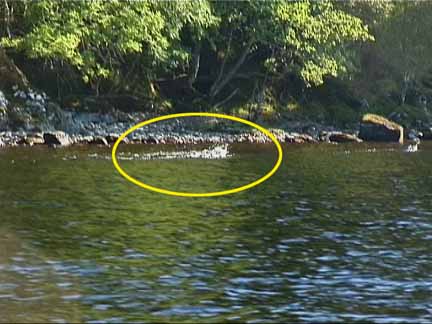Bird Effects
Bird Effects
The picture below is another still from the 1967 Raynor Film.
I can criticise it without fear of upsetting the photographer, since I am
the photographer. At the time, I recorded on my Sighting Report form that
I had the impression of one object at the front of the disturbance and
other objects catching up with it at times in the sequence. No-one seemed
to realise the significance of that observation at the time.
About 14 years later, I was employed as an engineer on the Wave Energy
Project of Sea Energy Associates / Lanchester Polytechnic. They had
a 1/10th scale test site at Dores, and that was where I spent most of my
time. One June day in 1981 I was looking out of the computer room window
when I saw something quite shocking. An object was travelling along the
surface of the loch at up to 10 miles per hour ( ~15 kph ) accelerating
and then slowing down just as my 1967 film had recorded. It was only 100
metres away, and after a few seconds I could see that it was a family group
of mergansers - one adult at the front was running along the surface away
from the group of seven or eight chicks, and after a few seconds it settled
back onto the water while the young ones caught up with it. A short time
later, the process was repeated.
That could have been what I saw and filmed from a range of one mile.
The group of birds often measured around 2 metres when spread out...entirely consistent with the JARIC measurement...
The average speed was around five miles per hour, as they estimated...
They were very accurate in their work, and only the failure of the camera system to resolve the individual birds at a range of one mile prevented , in my opinion, that particular mystery from being solved at that time.
For me, the sensible way is to wield Occam's Razor and go for the simple solution to this once enigmatic event. If the choice is between a family of mergansers which I know to live there, and a chance encounter with a dragon from Legend, sorry Dragon!.
Of course, I don't know that what I filmed was a group of birds, but that is the most reasonable explanation based on the available evidence. If someone can prove something different, I would be delighted.
Still from 1967 Raynor Film with Scott II in foreground.
This is a member of the British group of saw-billed ducks, together with the Goosander (- also found on Loch Ness) and Smew. The drake has a dark green head decorated with a double crest of long feathers hanging down the side. A broad white collar encircles the neck, and a white line runs down his nape to join his dark upper back. His lower back and flanks are streaked with grey. His wings are black and white, crossed with two black bars, and there is more white on his shoulders. He has a chestnut coloured breast and white underparts, rump and tail.
The duck had a brown head and neck, her back is greyish brown, and her underparts are white.
The drake's eclipse plumage resembles that of the duck, as do the young. The bills and legs are red, and the drake measures 23 inches or 580mm in length, with a wing-span of about 21 inches or 530mm.
It is a graceful and expert diver, catching its diet of fish from depths of up to 5 metres and staying under for up to two minutes, although 20 seconds is more normal. After eating its fish at the surface, it makes a great flapping of its wings, and drinks some water. It likes to feed in shallow water where it swims with its head submerged. The numerous chicks, clad in reddish-brown down, are tended by the duck alone, the drake does not remain in the area.
From personal experience I can inform you that when they are fishing
in the shallows, and viewed from a passing boat at a distance of 50 metres,
they can be almost invisible. The rippled water can have a light grey element
from the reflected sky, and a dark brown element from the reflected shoreline,
matching the colour of the birds to perfection.
Horizontal strips from the four frames, about 130k file size, are here.
If you can find the duck, please let me know!

Copyright 2000 Dick Raynor

Copyright 2000 Dick Raynor

Sometimes it is best just to publish a picture, as no amount of argument will convince some people that birds can occasionally seem to have a head, neck and two humps in the finest monster tradition. Here, one chick is following closely while another is riding on mother's back. Cropped more closely it could be "Photo of the Year" (but don't try it, I know the Competition Judges...)
If necessary, right-click on the image and select play or loop.

Loch Ness Mergansers by Dick Raynor is licensed under a Creative Commons Attribution-NonCommercial-NoDerivs 3.0 Unported License.
Permissions beyond the scope of this license may be available at http://www.lochnessinvestigation.com/permissions.html.